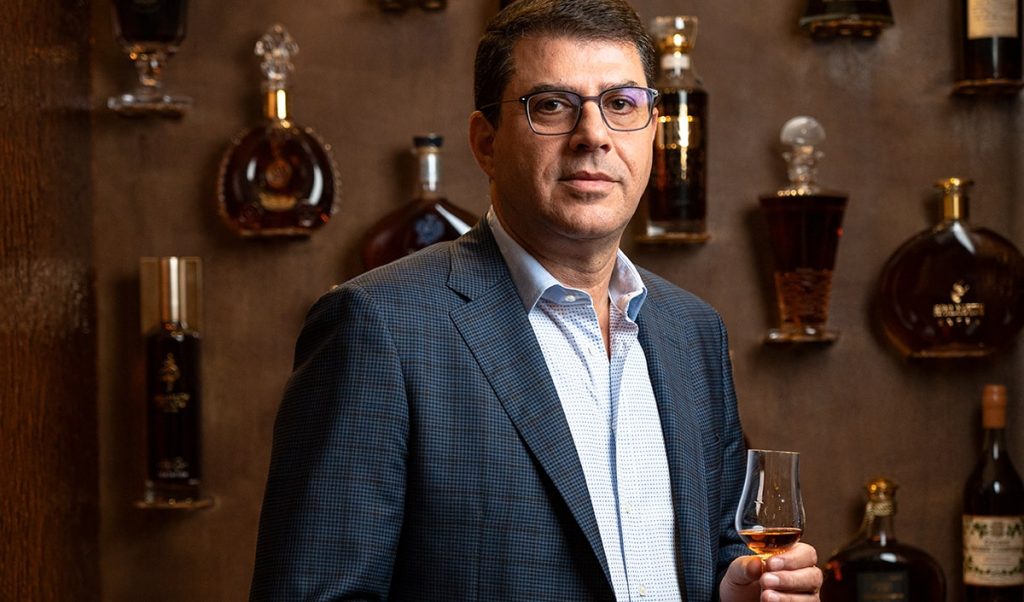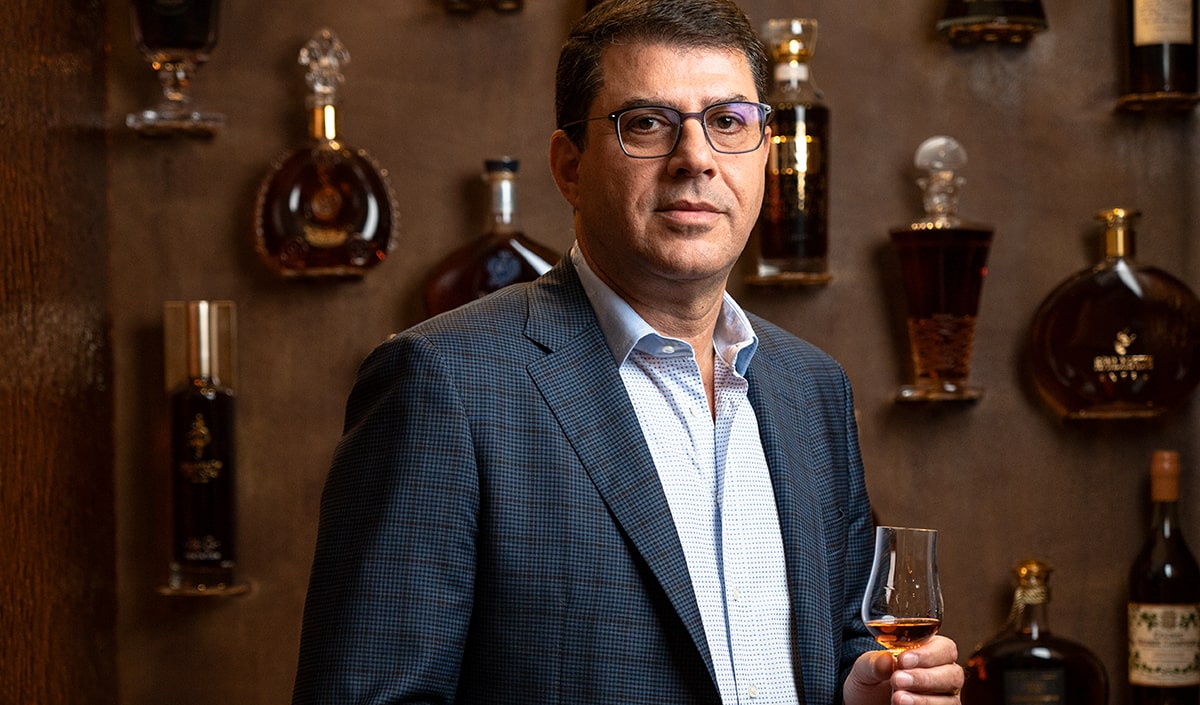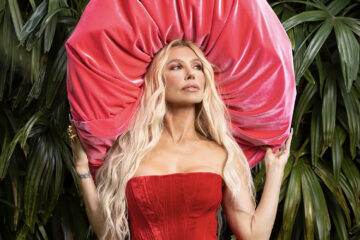Arthur Kilajian: Q&A With A Cognac Cognoscente
Exploring cognac culture with the help of cognac educator Arthur Kilajian.
Vanilla crème, lavender, burnt sugar, rich toffee, candied fruits, florals, baking spices, vanilla, marzipan and figs. Do these notes make you think of the perfect dessert? If you’re not thinking of cognac, think again. Some may argue that cognac, also known as eau de vie (only when it’s ageing in the barrel), is the best way to top everything off. This is true for Arthur Kilajian, one of 80 cognac educators in the world who helped us learn how to drink cognac artfully, savouring every drop of this sweet spirit
Q: When did your love, passion and enjoyment for cognac first develop? What’s your personal connection to cognac? Can you speak about your private collection?
A: My interest in cognac began 20 years ago. I felt that I needed a drink that would enhance my enjoyment of smoking fine cigars. Cognac is a perfect match, and I fell in love with it instantly. I developed my passion over the years by visiting the Cognac region in southwestern France and learning as much as I can about the spirit. There is so much to learn about cognac that one lifetime is not enough. I have been to the Cognac region over 20 times and visited over 60 cognac houses. I also collect cognac. My collection includes different types of cognac, as well as rare and beautiful bottles.
Q: When and why did you decide to become a cognac educator? What is a cognac educator?
A: I became a cognac educator in 2018, and I am one of only 80 in the world. I was disappointed by the lack of understanding of and appreciation for this noble spirit in Canada and decided that I can play an important role in sharing cognac knowledge and culture here at home. A cognac educator is accredited by the Bureau National Interprofessionnel du Cognac (BNIC), whose mission is to promote and educate about all aspects of cognac. As a cognac educator, I do not represent any brand. I hold events and masterclasses for those interested in learning about this luxurious spirit. These events are fun and educational, and often include food pairings and learning to train the nose to identify the different aromas of cognac.
Q: How do you see the demand for cognac within Canada and globally?
A: Producing cognac is a labour-intensive process, and this is why cognac demands a higher price than other spirits like whisky, rum and tequila, making it difficult to compete with them. Thanks to the four big cognac houses — Hennessy, Martell, Rémy Martin and Courvoisier — cognac is well promoted globally, but promotion is lacking in Canada. Cognac sales in Canada are not where they should be, and there is not enough variety available, especially in Ontario. There are over 280 brands of cognac, and we are lucky if we find more than five at our local liquor store.
Q: Can you give a brief history lesson on cognac from the late 1800s to the 1900s? What are the most noteworthy events when it comes to cognac?
A: The Cognac region had catastrophic damage in 1875 with the phylloxera bug that destroyed 85 per cent of the vineyards. Recovery took decades. The vineyards were finally saved, thanks to the grafting of the European vines onto American rootstock that was resistant to the insect.
Q: What does the process look like in making cognac? Are there any special techniques?
A: Vines are planted in the spring with grape varieties that have high acidity and low sugar, resulting in a low-alcohol wine. The most widely planted grape variety is Ugni Blanc. Grapes are harvested in September and immediately pressed, and then fermented. Up until this point, the process is similar to that of wine production. Cognac then undergoes a distillation using the Charentaise method. This is a double distillation in copper stills that produces eau de vie, a complex, aromatic and flavourful liquid that will produce cognac after aging in oak barrels, sometimes for over 80 years.
Q: What are the different styles of cognac?
A: Cognac can come from a single estate, a single cru, a single cask or a single year, or, most often, it is the product of a blending of all four. A cellar master blends the various eaux de vie in proportions that will produce the perfect cognac. A cellar master’s expertise is developed over a lifelong process of learning. Cognac is designated into categories that indicate the length of aging: Very Special (VS) is aged at least two years, Very Superior Old Pale (VSOP) is aged at least four years, Extra Old (XO) is aged at least six years, and the new designation Extra Extra Old (XXO) is aged at least 14 years.
Q: How would you describe the taste of cognac to someone who has never tried it before?
A: Cognac tastes fruity, sweet and spicy. Take your time in tasting the cognac. Take a small sip and swirl it in your mouth. Savour every flavour that it offers you. Cognac is not about drinking, but about appreciating the complexity of the spirit. Then, we can talk about the age of the spirit, the crus, the history and the different aromas.
Q: What glasses are meant to be used when drinking cognac?
A: Tulip glasses are the right ones, not balloon glasses. Tulip glasses allow for the aromas to be released gently while tasting.
Q: If someone wanted to use descriptors and sound educated when it comes to tasting cognac, what are some of the words/phrases you would suggest using to describe cognac?
A: There are over 60 different aromas of cognac, but to keep things simple, describe cognac by identifying it as floral, fruity, woody, earthy and spicy. Now, if you want to sound like an expert, talk about rancio aroma with older cognacs. This descriptor identifies more complex and developed notes, like blue cheese, mushrooms and nuts.
Q: What are some of your favourite cognacs/ cognac-makers from around the world?
A: Audry, Paul Giraud, Hardy, Hine, Delamain, François Voyer, Ragnaud Sabourin and too many more. If you get your hands on any of these bottles, consider yourself lucky!
Q: What are the six distinct cognac-making regions in the world, and what makes them special/distinct?
A: The regions are known as crus, and they are distinguished by soil type. They are: Grande Champagne, Petite Champagne, Borderies, Fins Bois, Bons Bois and Bois Ordinaires. Grande and Petite Champagne are considered the best due to their chalky and clay soil composition that is well suited to grow grapes that produce cognac of the highest quality with floral aromas. Borderies is the smallest cru, and it produces cognac with violet and iris aromas.
Q: What are three things that would surprise people about Cognac?
• Cognac is made from white grapes.
• Cognac does not continue to age once it is bottled.
• Cognac is brandy, but not every brandy is cognac.
Q: What is the best cognac experience you’ve ever had?
A: I have had too many to mention, but tasting cognac straight from a 1906 or 1929 barrel with a cellar master may be top on the list. Or, having a sip of a pre-phylloxera cognac.
Q: What are different ways to enjoy cognac?
A: Cognac can be enjoyed in many different ways. Cognac VS works very well in cocktails. There are over 100 different cocktails that can be made with cognac. Younger cognac can also be chilled or served over ice. And, of course, older cognac should be enjoyed neat.
Q: What would you suggest pairing with cognac? What has been the best pairing you’ve ever experienced?
A: Cognac pairs perfectly with blue cheese, duck, chocolate and crème brûlée. In my masterclasses, we often pair cognac with a full-course meal. My favourite pairing is chilled cognac with fresh oysters.
Q: Who is the most interesting person you’ve met thanks to the community around cognac?
A: I have learned so much from all the cellar masters who work in the cognac industry. Their highly trained and sensitive sense of smell and ability to identify the smallest differences in aromas, colours and tastes make them all celebrities in their own right.
Q: Where in the world do you think people appreciate cognac and the art of cognac most?
A: In the United States, cognac VS makes up 80 per cent of the total market and is used mostly in cocktails. Cognac is hyped up in the U.S. by celebrity hip-hop artists. It has almost become synonymous with rap music. In China and the Far East, there is a lot of understanding of and appreciation for high-quality cognac. I would like to see more interest in this prestigious spirit here in Canada.
Q: If you were a cognac, which one would you be and why? What year would you be?
A: I would be a cognac from a small house in Grande Champagne, where my great-grandfather planted the vines, my grandfather distilled the wine, and my father bottled the cognac. The vintage year doesn’t matter as much as the age in the barrel does.
Q: What is the biggest difference between a cognac lover and any other individual interested in a different type of alcohol (i.e., wine, etc.)?
A: I would say that a cognac lover has a more sophisticated palate and a lot of patience to appreciate this spirit.
Q: What does la dolce vita mean to you?
A: A glass of cognac in one hand and a cigar in the other, enjoyed during an in-depth and meaningful conversation with friends.
@cognacpassion















































































